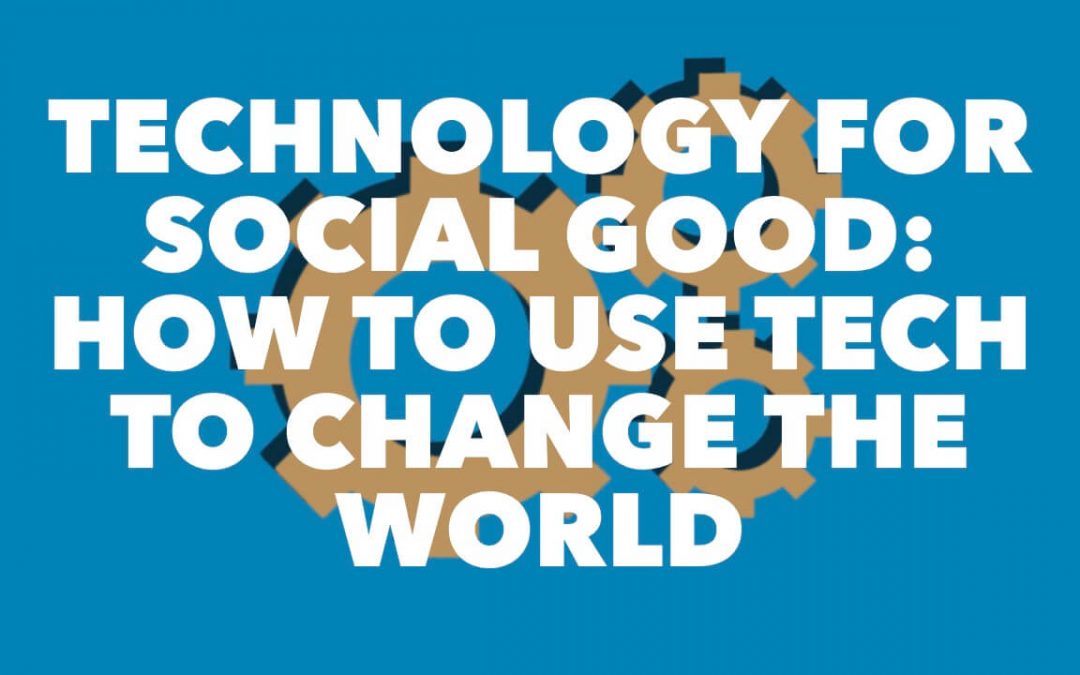Technology is becoming essential since it permeates all aspects of life. Consider your daily routine and tally all of the tech gadgets you use in a single day.

In reality, the amount of time individuals spend using tech grows daily, whether through communication, transportation, searching for information, or even entertainment. However, as tech continues to advance tech for social good is likely to become one of the most important topics of our time.
We see an incredible rise in tech-based initiatives to make today’s world a better place. So how can you use tech to make a difference? This blog post will explore some of the best ways to use tech for social good.
What Is Technology?
The study of technology is the scientific and practical knowledge that concerns the invention, implementation, and application of technical methods and their interaction with life, society, and the environment.
Technology refers to any application manufactured or created using applied science/math to address a societal problem. These may be agricultural technologies used by ancient civilizations or computational technologies like those employed today.

Ancient technologies such as the calculator, compass, calendar, battery, ships, or chariots are examples of old technologies that were integrated into our lives. Alternatively, current tools such as computers, robots, tablets, mobile phones, and 3D printers can all fall under new tech.
On the other hand, tech implies utilizing scientific knowledge to achieve a goal or developing apps used in industry or daily life. Thus, when you utilize scientific knowledge to achieve a goal, you utilize tech.
What Is Society?
A society is a social gathering of individuals who live together in a community, which may include some government/governance, rules, and an economy.
The latter, in ancient civilizations, was generally involved with farming, as well as imports and exports. In contrast, such groups frequently included armies and educational institutions, developing into advanced kingdoms and even empires with subordinate states.
The most technologically advanced states frequently evolved into great empires that dominated other nations/kingdoms.
How Technology May Assist Nonprofits in Extending Their Reach
The following are four ways that technology may help your nonprofit be more efficient:
1. Cloud-Based Tech Can Cut Costs
The good news is that you may already be using cloud-based tech without even knowing it. It entails utilizing the internet to run programs and store data via internet sharing services. Email, Google Drive, social networking, and internet conferences are the most frequently used.

Nonprofits can benefit from cloud computing technologies by saving time and money through their efficient procedures. This sort of tech may be used anywhere with an internet connection, enabling users to interact with individuals worldwide in real-time. It allows organizations to be more flexible and reduce costs spent on paper and printing.
2. Use CRMs to Automate Data Collection
CRMs (donor databases) or similar systems are some of the essential tools for keeping track of and analyzing your donor data. You might use automated surveys, for example, to compile and upload data into your CRM.
This eliminates the need for manual data entries and allows you to access all of your information in one location, saving time for your employee. This data can be combined to form a complete view of donors’ giving patterns, which will aid you in developing your entire fundraising strategy.
Furthermore, many CRMs enable companies to engage potential donors directly through communications and marketing tools. CRMs are also helpful for managing your personnel, board members, and volunteers using data from employee management systems.
3. Communications Technology Allows for a Diverse Strategy
The scope and accessibility of NGOs’ audiences have exponentially risen due to marketing and communications tech advancements. Nonprofits may use tech advancements to contact donors more quickly and inexpensively through Gmail, webpages, mailed materials, manual and automated phone calls, social media, mobile apps, etc.

With different alternatives available, it’s critical to use them to their full potential by learning about their donors’ preferred communication channels. This can assist nonprofits in delivering more effective, targeted communications with a higher return on investment (ROI) per outreach since individuals are more likely to respond than mass campaigns.
Many of these platforms may be repurposed for fundraising: if your non-profit texts donors asking for money, you should already have mobile donation capability. Convenience should be a priority for maximizing your donor’s participation. It will also assist you in keeping donors engaged while you have their attention.
4. Online Fundraising Offers New Sources and Simplifies the Giving Procedure
The internet can help you locate thematically specific, small grants for NGOs in developing countries and new ways to fundraise online. The rise of online donation forms and crowdfunding platforms has revolutionized conventional fundraising.
Your organization can avoid turning away potential donors with lengthy or complicated donation processes by shortening the procedure and making it more accessible. With online donations, your organization can immediately accept the gift, acquire valuable donor data (which will be transferred into a CRM), and begin long-term interactions with donors through automated (but personalized) receipts.
The Impact of Technology on Human Existence
Technology, in general, has improved human life from antiquity until the present by solving problems associated with day-to-day living, making many activities easier. Tech has made it easier to farm, more practical to build cities, and more convenient to travel globally, among other things.

All countries on earth are increasingly linked by tech, which is helping to create globalization and making it more straightforward for economies to develop and companies to operate. Virtually every aspect of human existence may be managed more efficiently, effectively, and quicker due to technological solutions, resulting in fewer issues on the one hand and more difficulties on the other.
The Positive Impact of Technology on Society
1. Mechanization of Agriculture
With the automation of agriculture, traditional agricultural techniques have seen a remarkable digital transformation. Mechanization refers to replacing old farming techniques such as working animals and manual labor with tech(including robots).
This has caused a shift in agricultural technology, with more automated, more efficient farming methods resulting in far more food calories for a more significant number of people.
2. Improvement of Transportation
The invention of trains, buses, automobiles, airplanes, speed boats, and other transportation technology has made it feasible for people to reach their necessary destination in a lot less time. With ridesharing applications like Uber and Grab, it’s now quite simple to get to a destination swiftly and affordably.
The foundation of any society is its infrastructure, which comprises both telecommunication and transportation networks. Thus the advancement of both has had a significant social impact on today’s world.
3. Communication Improvement
Telecommunication systems are a vital feature of all advanced societies. In an increasingly globalized world, people may remain in touch through the faster, more efficient, more effective, and more global system of email, phone calls, and mobile apps.

It’s entirely conceivable for people to live worldwide and stay in touch. It is even feasible for remote workers or international businesses to conduct video conferences via the internet to keep their operations going without interruption.
4. Enhancing the Education System and Learning Process
In today’s world, acquiring almost any skill needed to succeed is as simple as searching the internet, listening to a podcast, or watching a YouTube video. You can even use an automated phone call to teach financial skills. Compared to the difficulties of learning from printed books, ebooks and even online seminars enable individuals to remember faster, more efficiently, and conveniently.
The internet and online gateways have also allowed educational institutions to offer more user-friendly instructional materials, allowing students to understand subjects using computer systems they are already familiar with while collecting their study resources in one location.
5. Health
Computational technologies have been used to monitor, analyze, and change personal health habits via wearables like smart bracelets and health apps. Modern health systems now include computer systems with sophisticated security standards. Advanced apps may gather health information from patients using WiFi-enabled nano-pills.

Most healthcare providers now provide online access to patient information, and many hospitals have internet gateways that enable patients to retrieve their medical records or contact their doctor quickly.
6. Business
Technology has had a tremendous impact on large and small businesses in modern societies. Almost every successful technological development has expanded business possibilities, molded business models, and resulted in new products and services, resulting in new imports/exports at a national level and worldwide.
How to Use Tech to Promote Social Change
Here are various ways to promote and drive social change with and for your organization.
1. Share Essential Information and News
Spreading vital information before the internet required you to make expensive media purchases, distribute pamphlets of questionable efficacy, or go on time-consuming trips and personal appearances.

You may use a corporate website to provide all of the information necessary to understand your campaign and the steps that must be completed for change to occur with the internet. You may also use social media to spread the word about your work, keeping individuals informed on any updates or news that impacts your issue.
2. Create an Engaged Community
Many volunteer options are available to organizations working for social change, and finding individuals to undertake those opportunities has never been more accessible. People who share your interests may be able to see you on the internet. You may also discover them through internet message boards and social media postings.
Volunteering is one of the many ways you can get individuals involved. You may build a network of volunteers, activists, donors, and interested citizens by engaging online. You don’t have to pay for public gathering spaces. You may do so on the internet.
3. Provide Training and Education
The internet has a wealth of training and instructional resources, whether you’re talking about your chosen social change model, preparing a demonstration, staging a canvassing event, or simply informing others about the need for your cause.

You may use an online training platform, develop online courses, or send educational materials by email and other internet approaches. The only thing that limits you is the number of resources you have.
4. Receive Ground-Level Reports
It’s impossible to be everywhere at once. But you may have eyes and ears worldwide if you have a robust community—online or offline.
For example, suppose you work for a national civil rights organization in Detroit and one in San Francisco. In that case, California is considering adopting prejudicial regulations, and you may follow the debate on social media from members of your internet community and allies. If you’re running a social change project in rural Cambodia, you might instead want to use text message surveys.
This might be pretty useful, providing you with up-to-the-minute, on-the-ground information. That may be the difference between taking action and being too late. Speaking of taking action…
5. Take Immediate Action
Social media platforms, like Twitter, have been used by social movements worldwide to plan and stage demonstrations. You may utilize the same approach to address problems that affect your cause.

The internet allows you to quickly contact and coordinate individuals for various purposes, including email marketing, representatives, and emergency assistance efforts for people in need.
6. Raise Funds
Depending on the size and needs of your company, the internet may help you save money by allowing you to avoid sending out costly mailers or standing in line with a donation bucket. You can manage and execute large fundraising campaigns entirely online.
There are numerous methods to make fundraising more accessible and the collection of funds more simple. You may also utilize crowdfunding to raise particular money for specific goals. These efforts might be effectively promoted through social media if done well.
6 Digital Tools to Increase the Visibility of Your NGO
The following are the five ways to increase your visibility:
1. Social Media
Most NGOs’ target audience comprises donor agencies, corporate organizations, and the general public. These groups ‘ members use social media to stay connected professionally and be updated with the newest trends.
Share inspirational stories about persons whose lives have been transformed by the organization’s aid to get people’s attention. According to research, images and short videos effectively keep readers interested and prompt them to engage with the content by liking or commenting.
Sharing and engaging with your followers regularly is one approach to spreading the word about your cause. You can tag influencers and big businesses, add hashtags to your posts, and use relevant captions with keywords to improve the reach of your content. Furthermore, followers gain popularity when they re-share the content with their close networks.
2. WhatsApp Chat Bots (and Other Automated Responders)
If you’re a smaller organization you likely can’t be available 24/7 on social media and all hotlines and places you can be reached. Chat bots can fill that gap.
Let’s say you’re using a WhatsApp Business number to regularly send out nutritional information and answer people’s questions. If someone messages you after opening hours, you might still want to let them know their concern has been heard and you’ll get back to them in the morning. That’s what an auto-responder does.
A WhatsApp chat bot can even go a step further. If well designed, it can answer the most obvious, frequently asked questions and take that hurdle away from you.
3. Crowdfunding Platform
Crowdfunding platforms like Gofundme or Indiegogo allow nonprofits to interact directly with donors. Unlike traditional door-to-door fundraising, these platforms allow companies to transcend national borders and appeal to donors worldwide. Donors can use them to identify causes that are a good fit for their values and a platform for NGOs to explain their goals.
The platform allows you to start a campaign in the form of documentaries, first-person appeals, or text-based tales. After that, they publish it on their website and social media accounts to raise awareness while also providing a call-to-action and payment option.
This makes online donations simple for those who want to contribute to the cause. Specific crowdfunding platforms provide extra multimedia services to boost their campaign.
4. Email Marketing
Email marketing might assist you in maintaining your position and interacting with donors. You may communicate the mission in a first-person style by sending emails to your audience. You could share posters, a story, video, newsletters, or anything else to convey the organization’s accomplishments in the emails.

Email appeals are an excellent method of fundraising. Those who identify with the cause can donate once they’ve read or seen what the organization accomplished or even do it with their peer groups.
5. Brand Participation
Some e-commerce platforms allow NGOs to collaborate to raise awareness or appeal for assistance. A small fee may be charged to the bill at the payment gateway to provide a charitable contribution. Customers can agree to pay or opt-out if they are not interested.
A short description of the organization and the cause is provided to pique their interest. Some platforms charge a set fee, while others are adaptable, and donors may choose how much money to contribute. Your company can benefit from this by obtaining more donors and generating income in the long run.
6. Video Campaigns
Videos are currently taking over the digital space. Every second person using their phones to watch videos could significantly impact your nonprofit company. According to research, using videos in social media or emails improves click rates and boosts a company’s visibility.
It’s critical to elicit feelings from the audience while making the video. This may be done by employing real-life instances, first-person interviews, and on-site photos. This increases the chances of them giving to your company.
Otherwise, individuals will share the video on social media to assist with promotion. Aside from sending it out via social media, you can post it on a YouTube channel or send them out through email.
Conclusion
Technological advancements have had a significant, almost unimaginable impact on human beings since the dawn of civilization. While it’s difficult to measure the overall effect on human society, tech has, without a doubt, made life more accessible, more pleasant, and more convenient.
However, when misused or produced carelessly, it has the potential to have catastrophic consequences, making it unsuitable for a variety of applications.

